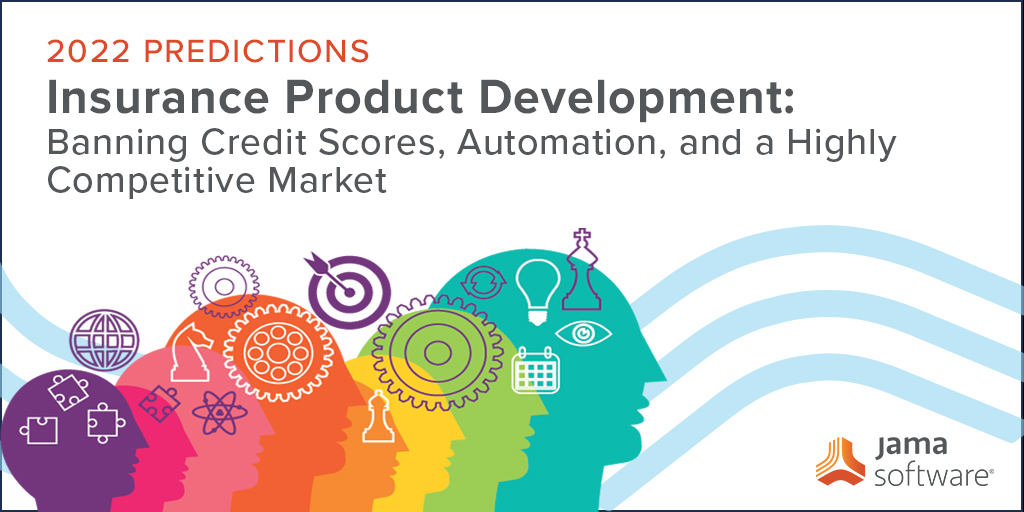In many ways, 2021 was a continuation of the changes brought about in 2020, a year that’s been described as “unprecedented” and “unparalleled.” In a unique way, 2021 has offered us an idea of evolving innovations and technology on the horizon for teams across industries. These changing conditions will present a variety of new landscapes and will offer unique challenges, opportunities, and more than likely, many surprises.
As we enter a new year of further changes, Jama Software asked select thought leaders – both internal and external – across various industries for the trends and events they foresee unfolding over the next year and beyond.
In the final part of our five-part series, we ask Alan Demers, President of InsurTech Consulting, LLC, to weigh in on product and systems development trends he’s anticipating for the insurance industry in 2022 and beyond.
Read our other 2022 Industry Predictions here: Part One – Engineering Predictions, Part Two – Medical Device Predictions, Part Three – Automotive Predictions, and Part Four – Aerospace & Defense Predictions.
Insurance Predictions
Design Trends
Q: What are the biggest trends you’re seeing in the insurance industry right now?
Alan Demers:
There are several noteworthy trends to consider and I think it may be helpful to divide them into insurtech related and general insurance ecosystem categories. The sustained emergence of insurtech is driving and inspiring growth in a variety of concepts like telematics usage-based auto insurance, use of geo-spatial, 3-D modeling and social data for underwriting and automation and digitalization of insurance are a few trends already underway. Artifical intelligence for predictive uses and conversational AI for services are gaining momentum while image analytics for virtual inspections has really taken off and is being broadly adopted by insurers and their customers. The ambition for insurers to automate and lower costs was met with an obvious surge in touch-free services because of Covid 19 which only added fuel to a burning fire. These are just a few examples among dozens of insurtech themes with countless solution providers joining the ranks each quarter, whether a startup or incumbent.
Overall, property and casualty insurance (P&C) ecosystem trends include; mergers and acquisition (M&A) activity among independent agency distribution and growth in direct channel sales among auto, home and small business. Post-pandemic return to miles driven and changing driver behaviors resulting in higher frequency of accidents and automobile technology, inflation and supply chain influences raising severity or cost of repairs. Insurance carrier legacy system transformational and cloud migration efforts are broadening. Cyber and climate /weather exposures, and social inflation (e.g., jury awards) are among the top trends as well.
Q: How will they impact insurance product, systems, and software development?
Alan Demers: Many of these trends are creating new and different product demand for changing exposures, like cyber risks, or to address competition and differentiation agendas. Consumer demand for ease of doing business will make concepts like embedded insurance models more popular, especially at point of purchase. Similarly, car manufacturer and insurance carrier partnerships will take usage-based-insurance, connected car features including on-board payments and services to a new level.
With respect to system development, insurer’s legacy core system transformations are separating carriers. Those carriers which have completed a policy administrative system transformation may be better positioned to accelerate product development. For example, taking advantage of new data feeds, API’s and partnership integrations that were previously on the back burner. Those carriers have not yet or are just beginning to address their core systems will be playing catch up because of the enormous costs, internal resources, and time required.
Overall competing priorities and deciding which areas to invest (core systems, insurtech development, new products, or automation choices) will continue to challenge insurers in terms of cost and deployment of finite resource availability.
Biggest Challenges
Q: What are some of the biggest challenges you think the Insurance market will be working to overcome in 2022?
Alan Demers: I think it is helpful to look at current year challenges understanding that the insurance industry tends to take the long view, both retrospectively and projecting forward. So far in 2022, talent competition is intensifying on top of managing remote and hybrid work teams. Given the industry is so traditionally people centric, sustaining employee productivity and collaboration will be put to the test as “return to the office” elongates and evolves.
In addition to changing workforces, cost reduction or expense ratio pressures because of the highly competitive marketplace will remain a priority. This means more automation and other areas of cost cutting focus. Profitability, in select areas like commercial auto and trucking lines which have been problematic over the last several years. Weather related risks and recent increasing reinsurance costs cause insurers to balance higher premiums and policyholder retention during a time when catastrophic events are increasing. Prioritizing exploration of new automation and insurtech investments while making gains through implementation and scaling other concepts already underway will remain a hurdle in 2022.
RELATED POST: The Top Challenges of Property Casualty Insurance Product Development
Regulations
Q: What changing regulatory guidelines do you anticipate having an impact on companies in 2022?
Alan Demers: Individual state regulations are constantly changing and updating in an already complex legal environment. However, consumer privacy and info-security will continue to be top areas of regulatory focus as insurers adopt new technology and partner with more startups. Again, we should expect more of the same in an already highly regulated industry which feeds into creating and sustaining a risk averse climate which can impede insurtech progress.
Tool Innovation
Q; From an insurance market toolset perspective, what are some of the processes you think forward-thinking firms will be working to leverage or incorporate into their process and why?
Alan Demers: The “why” portion is fairly straightforward to answer and is related to the highly competitive insurance market itself. Specifically, tools that will help automate and thus lower operating costs, differentiate to retain or grow customers and capabilities which may avoid or reduce losses are all promising motivators.
Insurers are working to advance self-service tools and greater digitization of process maturity to increase adoption. This has come a long way with much more room to improve, particularly when insurance services are compared to other industries like e-commerce or banking in terms of both adoption and satisfaction. Application of artificial intelligence (AI) for conversational, predictive, and computer vision applications are still early on and insurers are making investments and striving to apply them effectively. Doing so, will make insurance personalization, better pricing accuracy and also speed up, quote, bind and underwriting steps benefiting consumers while gaining efficiency in tandem.
RELATED POST: Customer Story: Farm Bureau Insurance Selects Jama Connect to Reduce Time-To-Market
Predictions
Q: What do you think will remain the same in your industry throughout 2022?
Alan Demers: In auto and homeowner lines the fight for market share gain within the top 10, especially the top five will remain. Expect to see more insurtech advancement due to high venture capital investment levels and as startups move through maturity cycles or get snatched up by insurers. The insurance ecosystem and large solution provider market places are expanding and will add partners making it somewhat easier insurer access. Overall, expect to see a relatively conservative, slow moving industry despite moving quicker than ever before. Like it or not, the US insurance industry is mainly a 100+ year conservative space.
Q: What do you predict for regulation in the Insurance market in 2022?
Alan Demers: One of the more talked about regulatory threats is the use of credit scoring which could be banned beyond states like CA, and recently in WA. Credit scoring is a heavily relied upon rating variable and predictive of future losses, despite growing concerns about fairness. Elimination of credit scoring could further pressure pricing and segmentation accuracy as carriers have come to rely upon credit scoring models for many years. Some carriers are better positioned with other rating variables and telematics and driver behavior programs. It is possible that some insurers could involuntarily reduce credit scoring and replace with driver scoring instead.
Q: Will those trends still be prevalent 5 years from now? 10 years?
Alan Demers: The way P&C insurance has changed since 2015 makes the next 5-10 years exciting to think about. For example, autonomous/connected/electric vehicles will be more advanced and prevalent in market and will further shape liability, insurable risks and insurance products themselves. Many of the other trends such as automation efforts, AI solutions, sensor technology for loss avoidance and detection and cyber crime exposures are likely to be in the insurance forefront in 2027-2032.
Thanks for tuning into our 2022 Predictions Series!
To see some of the incredible products, software, and systems our customers are building with Jama Connect, visit our CUSTOMER STORIES PAGE.
READ MORE

